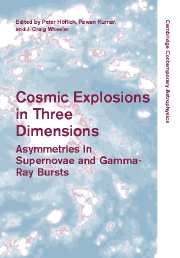Book contents
- Frontmatter
- Contents
- Part I Introduction
- Part II Supernovae: Observations Today
- Part III Theory of Thermonuclear Supernovae
- 10 Semi-Steady burning evolutionary sequences for CAL 83 and CAL 87: Super Soft X-ray binaries are supernova Ia progenitors
- 11 Type Ia progenitors: effects of spin-up of white dwarfs
- 12 Terrestrial combustion: feedback to the stars
- 13 Non-spherical delayed detonations
- 14 Numerical simulations of Type Ia supernovae: deflagrations and detonations
- 15 Type Ia supernovae: spectroscopic surprises
- 16 Aspherity effects in supernovae
- 17 Broad lightcurve SNe Ia: asymmetry or something else?
- 18 Synthetic spectrum methods for three-dimensional supernova models
- 19 A hole in Ia? Spectroscopic and polarimetric signatures of SN Ia asymmetry due to a companion star
- 20 Hunting for the signatures of 3-D explosions with 1-D synthetic spectra
- 21 On variations in the peak luminosities of Type Ia supernovae
- Part IV Theory of Core Collapse Supernovae
- Part V Magnetars, N-Stars, Pulsars
- Part VI Gamma-ray Bursts
- Part VII Conference Summary
- References
18 - Synthetic spectrum methods for three-dimensional supernova models
Published online by Cambridge University Press: 11 August 2009
- Frontmatter
- Contents
- Part I Introduction
- Part II Supernovae: Observations Today
- Part III Theory of Thermonuclear Supernovae
- 10 Semi-Steady burning evolutionary sequences for CAL 83 and CAL 87: Super Soft X-ray binaries are supernova Ia progenitors
- 11 Type Ia progenitors: effects of spin-up of white dwarfs
- 12 Terrestrial combustion: feedback to the stars
- 13 Non-spherical delayed detonations
- 14 Numerical simulations of Type Ia supernovae: deflagrations and detonations
- 15 Type Ia supernovae: spectroscopic surprises
- 16 Aspherity effects in supernovae
- 17 Broad lightcurve SNe Ia: asymmetry or something else?
- 18 Synthetic spectrum methods for three-dimensional supernova models
- 19 A hole in Ia? Spectroscopic and polarimetric signatures of SN Ia asymmetry due to a companion star
- 20 Hunting for the signatures of 3-D explosions with 1-D synthetic spectra
- 21 On variations in the peak luminosities of Type Ia supernovae
- Part IV Theory of Core Collapse Supernovae
- Part V Magnetars, N-Stars, Pulsars
- Part VI Gamma-ray Bursts
- Part VII Conference Summary
- References
Summary
Abstract
Current observations stimulate the production of fully three-dimensional explosion models, which in turn motivates three-dimensional spectrum synthesis for supernova atmospheres. We briefly discuss techniques adapted to address the latter problem, and consider some fundamentals of line formation in supernovae without recourse to spherical symmetry. Direct and detailed extensions of the technique are discussed, and future work is outlined.
Introduction
Spectrum synthesis is the acid test of supernova modelling. Unless synthetic spectra calculated from a hydrodynamical stellar explosion model agree with observations, the model is not descriptive. Some explosion modellers contend that only three-dimensional (3-D) models faithfully describe the physics of the real events. If this is so, then the evaluation of those models requires solutions to the 3-D model supernova atmosphere problem. These solutions require full detail, the inclusion of as much radiation transfer physics as possible. Otherwise, a bad fit of a synthetic spectrum to an observed one might have less to do with the accuracy of the hydrodynamical model, and more to do with the shortcomings of the radiation transfer procedure.
On the other hand, solutions (of a sort) to the ill-posed inverse problem constrain parameter space available to hydrodynamical models. Fast, iterative, parameterized fits to observed spectra characterize the ejection velocities and identities of species found in the line forming region. Most importantly, the procedure reveals species that cannot be identified by simply Doppler-shifting line lists on top of observed spectra in search of feature coincidences.
- Type
- Chapter
- Information
- Cosmic Explosions in Three DimensionsAsymmetries in Supernovae and Gamma-Ray Bursts, pp. 159 - 165Publisher: Cambridge University PressPrint publication year: 2004

